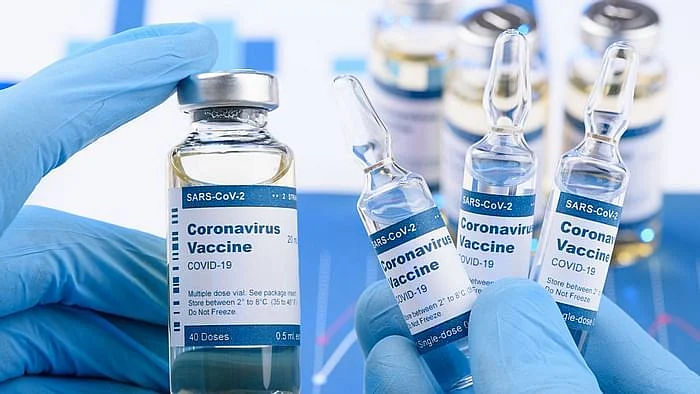
Is the Moderna COVID-19 Vaccine a Promising Option for India?
Do the Moderna early phase 3 trial results offer any hope for India? How is it different from the Pfizer vaccine?

advertisement
On Monday, 16 November, the US pharma company Moderna joined in the COVID-19 vaccine race by revealing that its candidate vaccine has shown 94.5 percent efficacy in early phase III trial results.
Stephane Bancel, Moderna’s CEO, said, “This positive interim analysis from our Phase 3 study has given us the first clinical validation that our vaccine can prevent COVID-19 disease, including severe disease,” reported Livemint.
Wipro founder-chairman Azim Premji is also reportedly an early investor in Moderna.
But do these results mean anything for India? Can we expect the vaccine to reach us in the near future? Let’s break it down.
What Do the Moderna and Pfizer COVID Vaccines Have in Common?
This is the second promising update coming in from the US within 10 days. Only last week, Pfizer and BioNTech had also announced that their coronavirus vaccine was more than 90 percent effective in preventing COVID-19.
Like the Pfizer vaccine, Moderna, too, uses the mRNA technology.
The technology is relatively new – it involves using genetic material from the virus called mRNA, which directs the body’s cells to stimulate the immune system. This method has not been used to create a vaccine so far.
Dr Shahid Jameel, Virologist and Director, Trivedi School of Biosciences at Ashoka University, when talking about Pfizer and mRNA, had told FIT, “This bodes really well for the future because it’s fairly simple to make RNA vaccines once you have the platform available. This also proves that you can take a small part of the virus structure, immunise with it and get protection. In this case, they didn’t even have to use the entire spike protein, but only a part of the spike protein. So yes, it is optimistic from many different angles.”
Pfizer or Moderna: What’s More Feasible in India?
Both the vaccine candidates have stringent temperature requirements, but the range varies considerably.
Moderna’s vaccine needs long-term storage at minus 20-degrees Celcius (minus 4 Fahrenheit), while the Pfizer vaccine requires minus 70-degree Celsius (minus 94 degrees Fahrenheit) or even lower – one of the coldest temperatures ever seen in a vaccine.
Pfizer and Biotech, along with other companies, are reportedly working on this challenge, investing in cold storage, freezers, transportation and temperature tracking devices. But the prospect of these reaching other countries, especially those without the required infrastructure, remains low.
Is the Moderna Vaccine More Viable Then?
Yes, the Moderna vaccine may have an edge over the Pfizer vaccine, considering the relatively higher temperatures it requires for storage. Moderna has also said that its vaccine remains stable at 2 to 8 degrees C (36 to 46 degrees F), the temperature of a standard home or medical refrigerator, for 30 days. Once the vaccine is taken out of a refrigerator for administration, "it can be kept at room temperature conditions for up to 12 hours.”
However, there is no arrangement for its supply in India so far.
Speaking to The Indian Express, Dr Gagandeep Kang, who is a professor at Christian Medical College, Vellore, said, “Moderna’s long-term storage is at minus 20°C, which is what we do with our polio vaccines. They have published information saying that their vaccine can stay out of minus 20°C for up to a month, so that makes it a much more feasible vaccine to deliver in our programmes.”
Dr Gavinder Gill, a vaccine expert, also said, “If it really came down to a choice between the Pfizer and Moderna candidates for a developing country, then the Moderna candidate would offer a benefit. I would say that neither one of those is ideal for a developing country.”
"We believe that our investments in mRNA delivery technology and manufacturing process development will allow us to store and ship our COVID-19 vaccine candidate at temperatures commonly found in readily available pharmaceutical freezers and refrigerators," stated Juan Andres, Chief Technical Operations and Quality Officer at Moderna.
Other Concerns: Cost, Scale, Distribution
Dr Kang highlighted the fact that the Moderna vaccine is not a ‘public health’ product for middle and low-income countries, making it a costly option. “The problem will be cost, because Moderna has said that their vaccine will cost $37 (more than Rs 2,750), which is a lot. It is now clear that this is not a public health product for low- and middle-income countries, unless the price is a tenth [of the current price] or less.”
In addition to the cost conundrum comes the scale at which a vaccine would be needed to immunise the people in India, Dr Gill said.
In fact, research by Credit Suisse has predicted that the three vaccines India is banking on right now are: Oxford/AstraZeneca, Novavax and J&J, as their temperature range is 2-8-degree Celsius. Moderna or Pfizer do not feature in the list, the bottleneck being cold storage infrastructure (especially refrigerated vans).
Regardless, reports have suggested that the Indian government is in dialogue with both domestic and international vaccine manufacturers (including Moderna and Pfizer) for COVID vaccines.
“Not only with Moderna, the government is also in communication with Pfizer, Serum Institute, Bharat Biotech and Zydus Cadila for their COVID-19 vaccine candidate in terms of safety, immunogenicity and efficacy,” news agency PTI reported quoting a senior government official.
However, the storage, transport and distribution of the mRNA vaccines would continue to be a critical issue – within and outside the United States.
(The article was first published in FIT and has been republished with permission)
(At The Quint, we question everything. Play an active role in shaping our journalism by becoming a member today.)
- Access to all paywalled content on site
- Ad-free experience across The Quint
- Early previews of our Special Projects
Published: undefined